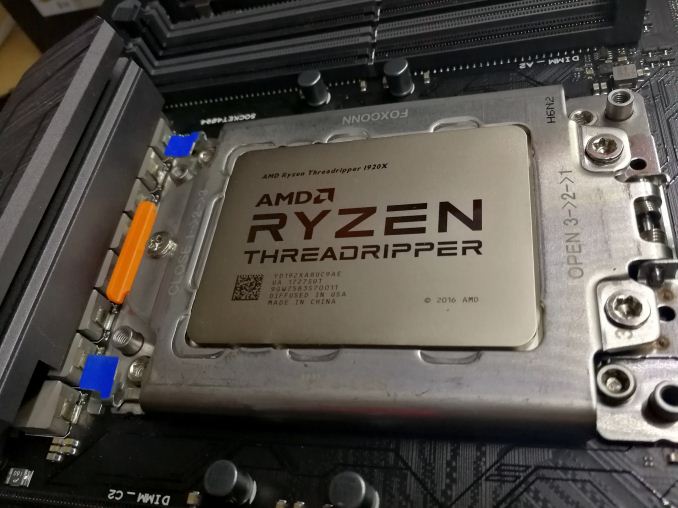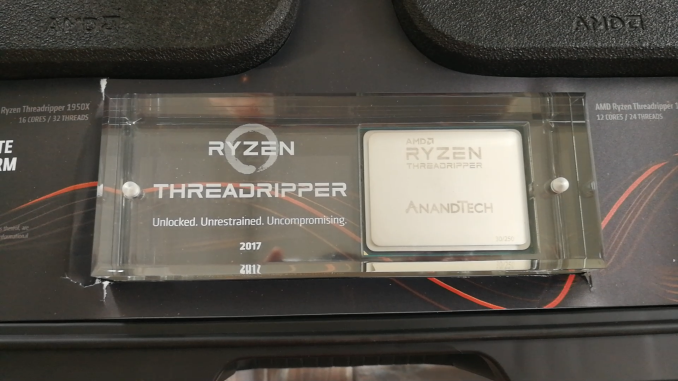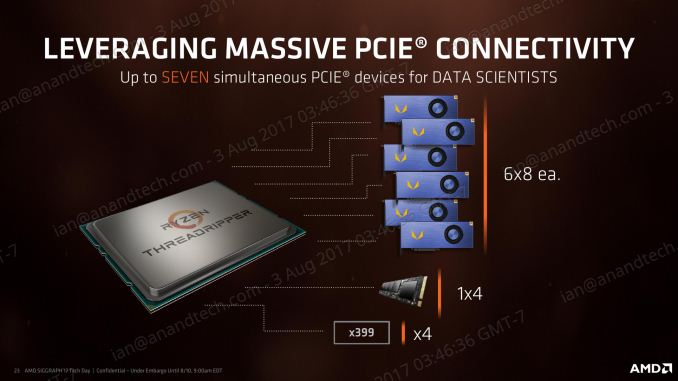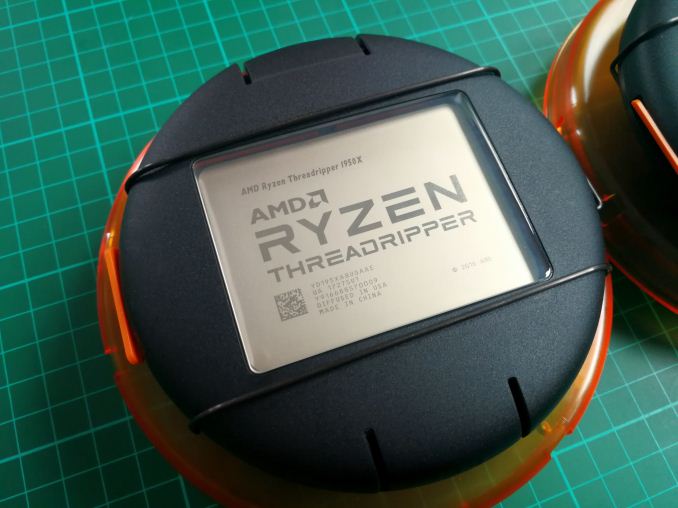The AMD Ryzen Threadripper 1950X and 1920X Review: CPUs on Steroids
by Ian Cutress on August 10, 2017 9:00 AM ESTFinal Thoughts: Do or Do Not - There is no Try
In this review we’ve covered several important topics surrounding CPUs with large numbers of cores: power, frequency, and the need to feed the beast. Running a CPU is like the inverse of a diet – you need to put all the data in to get any data out. The more pi that can be fed in, the better the utilization of what you have under the hood.
AMD and Intel take different approaches to this. We have a multi-die solution compared to a monolithic solution. We have core complexes and Infinity Fabric compared to a MoDe-X based mesh. We have unified memory access compared to non-uniform memory access. Both are going hard against frequency and both are battling against power consumption. AMD supports ECC and more PCIe lanes, while Intel provides a more complete chipset and specialist AVX-512 instructions. Both are competing in the high-end prosumer and workstation markets, promoting high-throughput multi-tasking scenarios as the key to unlocking the potential of their processors.
| The Battle | |||||||||
| Cores/ Threads |
Base/ Turbo |
XFR/ TB |
L3 | DRAM 1DPC |
PCIe | TDP | Cost (8/10) |
||
| AMD | TR 1950X | 16/32 | 3.4/4.0 | +200 | 32 MB | 4x2666 | 60 | 180W | $999 |
| Intel | i9-7900X | 10/20 | 3.3/4.3 | +200 | 13.75 | 4x2666 | 44 | 140W | $980 |
| Intel | i7-6950X | 10/20 | 3.0/3.5 | +500 | 25 MB | 4x2400 | 40 | 140W | $1499 |
| AMD | TR 1920X | 12/24 | 3.5/4.0 | +200 | 32 MB | 4x2666 | 60 | 180W | $799 |
| Intel | i7-7820X | 8/16 | 3.6/4.3 | +200 | 11 MB | 4x2666 | 28 | 140W | $593 |
What most users will see on the specification sheet is this: compared to the Core i9-7900X, the AMD Ryzen Threadripper 1950X has 6 more cores, 16 more PCIe lanes, and ECC support for the same price. Compared to the upcoming sixteen core Core i9-7960X, the Threadripper 1950X still has 16 more PCIe lanes, ECC support, but is now substantially cheaper.
On the side of the 1920X, users will again see more cores, ECC support, and over double the number of PCIe lanes compared to the Core i7-7820X for $100 difference. Simply put, if there is hardware that need PCIe lanes, AMD has the solution.
In our performance benchmarks, there are multiple angles to describe the results we have collected. AMD is still behind when it comes to raw IPC, but plays competitively in frequency. Intel still wins the single threaded tasks, especially those that rely on DRAM latency. AMD pulls ahead when anything needs serious threads by a large amount, and most of the time the memory arrangement is not as much of an Achilles heel as might be portrayed. If a user has a workload that scales, AMD is bringing the cores to help it scale as wide as possible.
Despite Threadripper's design arguably being better tuned to highly threaded workstation-like workloads, the fact that it still has high clocks compared to Ryzen 7 means that gaming is going to be a big part of the equation too. In its default Creative Mode, Threadripper’s gaming performance is middling at best: very few games can use all those threads and the variable DRAM latency means that the cores are sometimes metaphorically tripping over themselves trying to talk to each other and predict when work will be done. To solve this, AMD is offering Game Mode, which cuts the number of cores and focuses memory allocations to the DRAM nearest to the core (at the expense of peak DRAM bandwidth). This has the biggest effect on minimum frame rates rather than average frame rates, and affects 1080p more than 4K, which is perhaps the opposite end of the spectrum to what a top-level enthusiast would be gaming on. In some games, Game Mode makes no difference, while in others it can open up new possibilities. We have a full article on Game Mode here.
If I were to turn around and say that Threadripper CPUs were not pure gaming CPUs, it would annoy a fair lick of the tech audience. The data is there – it’s not the best gaming CPU. But AMD would spin it like this: it allows the user to game, to stream, to watch and to process all at the same time.
You need a lot to do in order to fill 16 cores to the max, and for those that do, it’s a potential winner. For anyone that needs hardcore throughput such as transcode, decode, rendering such as Blender, Cinema 4D or ray-tracing, it’s a great CPU to have. For multi-GPUs or multi-storage aficionados or the part of the crowd that wants to cram a bunch of six PCIe 3.0 x8 FPGAs into a system, AMD has you covered.
Otherwise, as awesome as having 16 cores in a consumer processor is – and for that matter as awesome as the whole Threadripper name is in a 90s hardcore technology kind of way – Threadripper's threads are something of a mixed blessing in consumer workloads. A few well-known workloads can fully saturate the chip – video encoding being the best example – and a number of others can't meaningfully get above a few threads. Some of this has been due to the fact that for the last 8 years, the bread-and-butter of high-end consumer processors have been Intel's quad-core chips. But more than that, pesky Amdahl's Law is never too far away as core counts increase.
The wildcard factor here – and perhaps the area where AMD is treading the most new ground – is in the non-uniform allocation of the cores. NUMA has never been a consumer concern until now, so AMD gets to face the teething issues of that introduction head on. Having multiple modes is a very smart choice, especially since there's a good bit of software out there that isn't fully NUMA-aware, but can fill the CPU if NUMA is taken out of the equation and the CPU is treated as a truly monolithic device. Less enjoyable however is the fact that switching modes requires a reboot; you can have your cake and eat it too thanks to mode switching, but it's a very high friction activity. In the long-term, NUMA-aware code would negate the need for local vs distributed if the code would pin to the lowest latency memory automatically. But in lieu of that, AMD has created the next best thing, as even in an ideal world NUMA is not without its programming challenges, and consequently it's unlikely that every program in the future will pin its own memory correctly.
In that respect, a NUMA-style CPU is currently a bit of a liability in the consumer space, as it's very good for certain extreme workloads but not as well balanced as a single Ryzen. Costs aside, this means that Threadripper isn't always a meaningful performance upgrade over Ryzen. And this isn't a catch unique to AMD – for the longest time, Intel's HEDT products have required choosing between core counts and top-tier single-threaded performance – but the product calculus has become even more complex with Threadripper. There are trade-offs to scaling a CPU to so many cores, and Threadripper bears those costs. So for the consumer market its primarily aimed at, it's more important than ever to consider your planned workloads. Do you need faster Handbrake encoding or smoother gameplay? Can you throw enough cores at Threadripper to keep the beast occupied, or do you only occasionally need more than Ryzen 7's existing 8 cores?
AMD has promised that the socket will live for at least two generations, so Threadripper 2000-series when it comes along should drop straight in after a BIOS update. What makes it interesting is that with the size of the socket and the silicon configuration, AMD could easily make those two ‘dead’ silicon packages into ‘real’ silicon packages, and offer 32 cores. (Although those extra cores would always be polling at far memory speeds).
This is the Core Wars. A point goes to the first chip that calculate the Kessel run in under twelve parsecs.














347 Comments
View All Comments
NikosD - Sunday, August 13, 2017 - link
Well, reading the whole review today - 13/08/2017 - I can see that the reviewer did something more evil than not using DDR4-3200 to give us performance numbers.He used DDR4-2400, as he clearly states in the configuration table, filling up the performance tables BUT in the power consumption page he added DDR4-3200 results (!) just to inform us that DDR4-3200 consumes 13W more, without providing any performance numbers for that memory speed (!!)
The only thing left for the reviewer is to tell us in which department of Intel works exactly, because in the first pages he wanted to test TR against a 2P Intel system as Skylake-X has only 10C/20T but Intel didn't allow him.
Ask for your Intel department to permit it next time.
Zingam - Sunday, August 13, 2017 - link
Yeah! You make a great point! Too much emphasis on gaming all the time! These processors aren't GPUs after all! Most people who buy PCs don't play games at all. Even I as a game developer would like to see more real world tests, especially compilation and data-crunching tests that are typical for game content creation and development workloads. Even I as a game developer spend 99% of my time in front of the computer not playing any games.pm9819 - Friday, August 18, 2017 - link
So Intel made AMD release the underpowered overheating Bulldozer cpu's? Did Intel also make them sell there US and EU based fabs so they'll be wholly dependant on the Chinese to make their chips? Did Intel also make them buy a equally struggling graphics card company? Truth is AMD lost all the mind and market share they had because of bad corporate decision and uncompetitive cpu designs post Thunderbird. It's no one's fault but there own that it took seven years to produce a competitive replacement. Was Intel suppose to wait till they caught up? And Intel was a monopoly long before AMD started producing competitive cpu's.You can keep blaming Intel for AMD's screw ups but those of us with common sense and the ability to read know the fault lays with AMD's management.
ddriver - Thursday, August 10, 2017 - link
You are not sampled because of your divine objectivity Ian, you are sampled because you review for a site that is still somewhat popular for its former glory. You can deny it all you want, and understandable, as it is part of your job, but AT is heavily biased towards the rich american boys - intel, apple, nvidia... You are definitely subtle enough for the dumdums, but for better or worse, we are not all dumdums yet.But hey, it is not all that bad, after all, nowadays there are scores of websites running reviews, so people have a base for comparison, and extrapolate objective results for themselves.
ddriver - Thursday, August 10, 2017 - link
And some bits of constructive criticism - it would be nicer if those reviews featured more workloads people actually use in practice. Too much synthetics, too much short running tests, too much tests with software that is like "wtf is it and who in the world is using it".For example rendering - very few people in the industry actually use corona or blender, blender is used for modelling and texturing a lot, but not really for rendering. Neither is luxmark. Neither is povray, neither is CB.
Most people who render stuff nowadays use 3d max and vray, so testing this will actually be indicative of actual, practical perforamnce to more people than all those other tests combined.
Also, people want render times, not scores. That's very poor indication of actual performance that you will get, because many of those tests are short, so the CPU doesn't operate in the same mode it will operate if it sweats under continuous work.
Another rendering test that would benefit prosumers is after effects. A lot of people use after effects, all the time.
You also don't have a DAW test, something like cubase or studio one.
A lot of the target market for HEDT is also interested in multiphysics, for example ansys or comsol.
The compilation test you run, as already mentioned several times by different people, is not the most adequate either.
Basically, this review has very low informational value for people who are actually likely to purchase TR.
mapesdhs - Thursday, August 10, 2017 - link
AE would definitely be a good test for TR, it's something that can hammer an entire system, unlike games which only stress certain elements. I've seen AE renders grab 40GB RAM in seconds. A guy at Sony told me some of their renders can gobble 500GB of data just for a single frame, imposing astonishing I/O demands on their SAN and render nodes. Someone at a London movie company told me they use a 10GB/sec SAN to handle this sort of thing, and the issues surrounding memory access vs. cache vs. cores are very important, eg. their render management sw can disable cores where some types of render benefit from a larger slice of mem bw per core.There are all sorts of tasks which impose heavy I/O loads while also needing varying degrees of main CPU power. Some gobble enormous amounts of RAM, like ANSYS, though I don't know if that's still used.
I'd be interested to know how threaded Sparks in Flame/Smoke behave with TR, though I guess that won't happen unless Autodesk/HP sort out the platform support.
Ian.
Zingam - Sunday, August 13, 2017 - link
Good points!Notmyusualid - Sunday, August 13, 2017 - link
...only he WAS sampled. Read the review.bongey - Thursday, August 10, 2017 - link
You don't have to be paid by Intel, but this is just a bad review.Gothmoth - Thursday, August 10, 2017 - link
where is smoke there is fire.there are clear indications that anandtech is a bit biased.